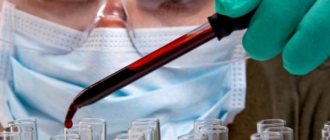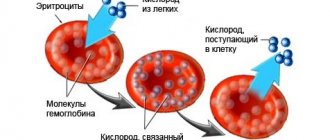Thrombocrit is the proportion of whole blood volume that is taken up by platelets (blood platelets).
Thrombocrit in the blood (platelet crit, PCT or pct) is an analogue of hematocrit (HCT), however, if the determination of hematocrit is still to some extent, albeit approximately, possible after spontaneous sedimentation of erythrocytes, then with thrombocrit this is not possible.
Outside the bloodstream, platelets, finding themselves on a foreign surface (for example, in a container intended for blood), receive pseudopodia, significantly increase in size (up to 10 times), then stick together and form aggregates.
This feature of platelets makes their examination problematic, as well as their storage for transfusion (it is necessary to maintain a state of rotation), therefore, in the case of thrombocrit, an automatic analyzer turns out to be indispensable.
Thrombocrit is not widely used.
Why do a thrombocrit test?
Why determine thrombocrit:
- Determining the patient's tendency to increased blood clots or bleeding.
- Thrombocrit can be used to assess the risk of possible complications when choosing preventive treatment.
Any physician should consider the platelet count in the study of his patient's blood clotting.
Typically, platelets are not included in the general indicators, and their analysis is carried out only at the request of doctors. This fact is due to the complexities of thrombocrit analysis technology.
The fact is that platelets have a special property: when moving into a “foreign” space, they grow almost tenfold due to the formation of pseudopodia (false legs). After this, the platelets stick together into aggregates - small particles.
This indicator correlates with the MPV indicator - this is the average volume of measured platelets: the higher the MPV indicator, the higher the thrombocrit (PCT), and accordingly, a decrease has the same effect on both indicators.
Significance in diagnosis
First of all, by determining thrombocrit indicators, the following aspects are established:
- Determination of the risk of bleeding, increased thrombosis (thrombocytosis condition).
- Assessment of the benefit/risk ratio when prescribing certain medications.
The most well-known reasons for determining this indicator in the blood are:
- The patient has a high temperature of unknown origin.
- Evaluation of treatment with immunosuppressive drugs.
- Severe viral, bacterial, fungal infection of the body.
- The patient is on artificial ventilation.
- Complications after organ transplantation.
Important. It is necessary to take into account that any change in the number of platelet germ cells - an increase (thrombocytosis), a decrease (thrombocytopenia), a change in shape, aggregation - immediately affects the thrombocrit numbers.
To assess platelet distribution in peripheral blood, it is necessary to know its normal values.
What is the normal thrombocrit level?
In a general blood test, thrombocrit characterizes the content of platelet mass in whole blood, informing about an unacceptable increase or decrease in platelets in the patient.
If the thrombocrit is in the range from 0.15 to 0.4, then this means that it is normal (different sources indicate other normal values: 0.11 - 0.28, 0.12 - 0.38, 0.12 -0.36...).
Science does not distinguish between the norm of this indicator in an adult and an infant (that is, if the thrombocrit indicator is elevated in a child, this is not due solely to his age).
The platelet level indicators decrease or increase proportionally in accordance with the age of the patient, so there is no need to look for any differences in children.
Another thing is the physiological fluctuations of platelets:
- Seasonal and daily fluctuations can change the number of platelets by up to 10% (depression in the spring and at night) - the PCT (thrombocrit) indicator may be below normal or at the lower limit of normal.
- Menstruation can reduce PCT in women by 50%; PCT will also be reduced during pregnancy (this phenomenon is associated with the body’s protection from thrombosis).
- Platelets are also affected by physical activity: thrombocrit may increase (the value of the indicator can increase by 2 times).
Thrombocrit: what is it, norm and deviations, reasons for high and low
- Thrombocrit and its norm
- Above and below normal
+ Questions and answers from a specialist
© Z. Nelly Vladimirovna, laboratory diagnostics doctor at the Research Institute of Transfusiology and Medical Biotechnology, especially for SosudInfo.ru (about the authors)
Before the advent of analytical hematological systems that perform clinical blood tests automatically, such an indicator as thrombocrit did not appear among laboratory tests at all.
However, previously, platelets, although they were included in the list of parameters of a general blood test (CBC), were counted at the individual request of the attending physician (these cells require a special approach: preliminary lysis and a separate staining method).
Hematological analyzers not only count all blood cells without problems, but also calculate erythrocyte and platelet indices, hematocrit and thrombocrit, thereby freeing laboratory diagnostic doctors from tedious work associated with mathematical formulas.
Thrombocrit and its norm
Thrombocrit (PCT) is the proportion of the volume of whole blood that is taken up by blood platelets (platelets).
Thrombocrit is an analogue of hematocrit (HCT), but if hematocrit can somehow, albeit approximately, be determined after spontaneous sedimentation of erythrocytes, then this number does not work with this parameter.
Platelets outside the bloodstream, falling on a surface that is foreign to them (for example, a container in which blood was placed), acquire pseudopodia, significantly (up to 10 times) increase in size (what is the thrombocrit already?), then stick together and form aggregates.
This feature of platelets creates difficulties in their study, as well as in storage for transfusion (they must rotate all the time), so an automatic analyzer in this case turns out to be indispensable. Meanwhile, such a parameter as thrombocrit has not yet received widespread use.
Thrombocrit, as part of a general blood test, characterizes the percentage of platelet mass in the volume of whole blood and informs about an unacceptable decrease or increase in platelets in a particular patient. The norm for this indicator in the blood is 0.15 – 0.4 (in different sources: 0.12 –0.36, 0.12 – 0.38, 0.11 – 0.28...).
Science does not make any differences between normal values in children and adults ; platelet levels increase or decrease in proportion to each other in accordance with age, so you should not expect any special differences in a child. Another thing is physiological fluctuations in platelet count:
- Daily and seasonal fluctuations can change the number of plates by 10% (depression at night and in the spring) - PCT may be below normal or at the lower limit;
- Menstruation in women can reduce the indicator by 50%, PCT will also be reduced in pregnant women (this is due to natural protection against thrombosis);
- Platelets are also “not indifferent” to physical activity: the thrombocrit changes upward (perhaps 2 times higher than normal).
However, this parameter in the UAC is not studied to identify its physiological abilities. Perhaps it has another purpose?
Above and below normal
Thrombocrit is determined in order to assess the degree of risk of bleeding and/or thrombosis, and this, as we know, is already a threat to human life and health.
The reasons for the increase are most often associated with a disorder in the hematopoietic system or may result from the body’s reaction to other pathological processes that lead to stimulation of platelet production and change the indicators of the state of the platelet unit. Thrombocrit levels above normal (high or somewhat elevated) can be expected in the following pathological conditions:
- Myeloproliferative diseases (polycythemia, chronic myeloid leukemia);
- For some period (usually 2 months) after removal of the spleen;
- Conditions associated with iron deficiency in the body;
- Viral infections and inflammatory diseases of other etiologies;
- Increased thyroid function;
- Atherosclerotic process;
- Diabetes;
- Bad habit in the form of smoking.
It should be noted that platelet, thromocrit and thrombus have the same root; I think it is not necessary to explain to the reader what happens if PCT is significantly higher than normal? Thrombosis, heart attack, stroke...
Values of the indicator below the norm are no less dangerous. Severe hematological pathology, which is the main reason for the decrease in the number of blood platelets, also leads to 0 thrombocrit. The reasons leading to a reduced content of platelet mass in the blood volume (thrombocytopenia) may be related to:
- With inhibition of megakaryocytic growth and decreased production of blood platelets;
- With increased destruction and utilization of platelets.
Thus, thrombocrit can be reduced in many diseases of the blood system, chronic pathological processes of internal organs , as well as the influence of other factors that negatively affect the number and functional abilities of blood platelets:
- Aplastic anemia;
- Myelodysplastic syndrome;
- Megaloblastic anemia;
- Collagenoses;
- Hemoblastoses;
- Ionizing radiation, chemicals, including some medications (antibiotics, cytostatics);
- Tumors of hematopoietic tissue;
- Viral infections;
- Intoxication;
- Cirrhosis of the liver;
- CRF (chronic renal failure).
Of course, these are not all diseases that are characterized by increased or decreased thrombocrit. But if the reader is interested, more complete information about this indicator and other characteristics of blood platelets can be found in the sections devoted to the general blood test and platelets separately.
Display all posts with the tag:
- Analyzes
- Blood clotting
Source: https://sosudinfo.ru/krov/trombokrit/
When does thrombocrit increase?
The reasons for the increase in thrombocrit levels are associated with the reaction to pathology, stimulation of the platelet germ of hematopoiesis.
Most often, PCT values are elevated when:
- Iron deficiency anemia,
- After splenectomy (this is an operation to remove the spleen), an increase in PCT can persist for up to 2 months,
- Blood diseases that are associated with stimulation of the myeloid lineage (essential thrombocythemia, chronic myeloid leukemia, thrombocytopenic purpura, polycythemia),
- Inflammatory diseases of various etiologies (including fungal infections, bacteria),
- Tuberculosis,
- Hyperfunction of the thyroid gland,
- Viral attack (measles, flu, chicken pox in a child),
- Diabetes mellitus
- Laboratory blood tests
- Atherosclerosis of blood vessels,
- Osteomyelitis,
- Ulcerative colitis,
- Rheumatic attack,
- Fractures of tubular bones,
- In smokers - with nicotine intoxication,
- During a large-scale operation,
- Tissue necrosis (acute pancreatitis).
If an increase in this indicator is detected, the patient is at risk of developing:
- Thrombotic stroke (impaired blood supply to the brain).
- Acute coronary thrombosis with a probability of outcome in myocardial infarction.
The possibility of increased thrombosis should be taken into account when:
- Inpatient treatment,
- Prolonged bed rest,
- Upcoming surgery.
Drug treatment
Since increased thrombocrit is associated primarily with the risk of thrombosis, the main drugs to reduce it are antiplatelet agents and anticoagulants.
The most common types of medicines are shown in the table below:
| Name of the drug, release form | Active substance | Main indications | Dosage for adults, mg per day | Average price, rub. |
| Warfarex, tablets | Warfarin | Deep vein thrombosis, pulmonary embolism | 2,5-5 | 150 |
| Acetisalicylic acid (aspirin), tablets | Acetisalicylic acid | Prevention of ischemic circulatory disorders in the brain, fever, inflammatory pathologies of the joints | 150-8000 | 20 |
| Thrombo ass, tablets | Prevention of stroke and myocardial infarction, thromboembolism, deep vein thrombosis | 50-200 | 50 | |
| Curantil, tablets | Dipyridamole | Prevention of thrombosis and their complications, ischemic circulatory disorders in the brain, ischemic heart disease (especially with aspirin intolerance) | 75-600 | 570 |
| Clexane, injection solution | Enoxaparin sodium | Prevention and treatment of venous thrombosis and embolism, acute myocardial infarction | 20-40 | 580 |
Since these drugs can cause complications in the form of increased bleeding, they are prescribed only by a doctor. During treatment, monitoring of blood counts is required.
Why does thrombocrit decrease?
If the thrombocrit indicator is low, this indicates:
- Increased destruction
- Inhibition of platelet formation by effects on megakaryoblasts (precursor cells).
Most often, low thrombocrit is due to the following reasons:
- myelodysplastic syndrome,
- Anemia (megaloblastic and aplastic),
- Insufficient nutrition of folic acid, when its content is maintained below the required level for a month or more,
- Allergic diseases,
- Lupus erythematosus, as well as other collagenoses,
- Consequences of a course of chemotherapy,
- Blood tumors (hemoblastosis, leukemia),
- Exposure to toxic substances
- Penetrating radiation
- Negative effects of medications (antibiotics, cytostatics, corticosteroids, diuretics),
- Chronic renal and liver failure,
- Viral infections.
It is found during fetal asphyxia and in low-weight newborns. In older people, a connection between low thrombocrit and exposure to helminthiasis (parasitic infection) has been proven.
A dangerous consequence for the patient’s life can be his tendency to bleed, since any, even minor injuries can cause large blood loss. The most severe manifestation may be hemorrhage in the brain and other organs.
Reasons for lowering the PCT
A drop in the indicator also indicates pathological processes. Which ones exactly?
Megaloblastic anemia
Develops with a lack of vitamins B12, 9. Accompanied by impaired hematopoiesis. It switches to abnormal tracks: instead of mature formed cells, underdeveloped forms move into the channel.
They are unable to perform useful functions. Accordingly, the number of ready platelets is much less. A lower than normal thrombocrit also means that other forms of anemia are present. Read more about megaloblastic here.
Treatment. Impact dose of vitamins. Then you need to find out which disease was the main culprit of the problem. And fight him already.
Allergy
Intense immune response. False. Allergies are always accompanied by the destruction of red blood cells and the platelets themselves, which leads to a decrease in PCT in the analysis.
Attention:
The stronger the reaction, the more dangerous the consequences, including Quincke's edema and asphyxia (suffocation).
Treatment. Antihistamines. In more complex cases, glucocorticoids like Prednisolone or more powerful analogues are used. The question remains with the specialist.
Radiation sickness
Exposure to radiation. In peacetime it is almost impossible to meet her. Mostly patients receiving radiotherapy suffer. Especially if the required dosage is exceeded.
Worm infestations
Regardless of type and location. Treatment is carried out using specialized drugs. Which ones exactly are determined by the parasitologist. After researching the type of culprit organism. The effect occurs almost immediately. The indicators return to normal after a week. Plus or minus.
Malignant tumors
Any localization. Basically, we are talking about the bone marrow itself, as well as the thyroid and pancreas. Less often about the liver. Treatment is strictly surgical. The goal is to remove the abnormal formation completely. Then, if necessary, they resort to radiation and chemotherapy.
Poisoning
Acute intoxication with metal salts, non-metal vapors. Mercury, arsenic, and lead are especially dangerous. They provoke platelet death and clotting disorders. The greater the concentration of the toxic component, the more serious the consequences for the body.
Sometimes a decrease in thrombocrit is the result of natural factors. For example, PCT levels fall during pregnancy and breastfeeding (lactation). Deviations are possible due to hormonal fluctuations. A specialist should study the issue. At a minimum, a hematologist.
Manifestations of changes in thrombocrit levels
It is mandatory for the attending physician to prescribe a blood test for thrombocrit if there is a suspicion of the above diseases.
You should be aware of symptoms that may be associated with a decrease or increase in platelet count.
The patient has:
- General weakness
- Feeling worse
- Fingers and toes turn blue,
- Headache,
- Bruises form on the body,
- Painful sensations in the fingertips,
- Impaired vision
- Nosebleeds,
- Skin itching
- Blood in stool and urine,
- Women experience heavy periods.
Additional examinations if thrombocrit changes
To diagnose the disease, it is important to determine the cause of changes in thrombocrit levels. And a general blood test may not be sufficient for this.
Checked:
- Blood collection
- Bleeding time
- Clotting factors
- Prothrombin index, fibrinogen,
- Liver tests
- Protein composition,
- blood sugar
- Residual nitrogen, creatinine,
- Iron,
- Analysis of urine,
- If necessary, hormonal composition can be checked.
The doctor prescribes to the patient:
- Hardware studies using radiography and ultrasound.
- To check the patency of blood vessels, Doppler examination is indicated.
- If certain symptoms are detected, magnetic resonance imaging of the brain is prescribed.
- If there is a suspicion of a blood disease, a bone marrow puncture is prescribed.
- The correctness of the hematopoiesis process is checked.
Prevention in case of changes in thrombocrit values
If the thrombocrit is elevated, the doctor prescribes:
- Antiplatelet agents.
- Anticoagulants.
Their intake is necessary to reduce the risk of vascular thrombosis.
The duration of the course and dosage are determined by the attending physician. You cannot increase the dose or stop taking it on your own.
You should consult your doctor about the advisability of taking hormonal birth control and the need for diuretics.
The patient is recommended:
- Stop smoking.
- Avoid alcoholic beverages.
- Drink clean filtered water in an amount of at least two liters/day.
- The daily diet should include:
- Onion,
- Garlic,
- fish,
- Lemons,
- Tomatoes,
- Vegetable linseed oil,
- Fruits and berries,
- Meat,
- Beef
- Buckwheat,
- Liver,
- Dairy products,
- Seafood.
Not recommended:
- Bananas,
- Lentil porridge,
- Walnuts,
- Pomegranates and mangoes,
- Drinks with chokeberry.
If your thrombocrit level decreases, you should include in your diet:
- Vegetables and fruits,
- Be sure to eat fish or meat dishes every day,
- Fresh juices with viburnum, cranberries, sea buckthorn.
It is not recommended to consume products containing acetic acid and preservatives. Homemade preparations are also harmful to the body. You will have to exclude all kinds of allergens (citrus fruits, honey, eggs, chocolate).
To maintain normal thrombocrit, the patient is recommended to:
- Reduce the likelihood of minor injuries.
- Limit physical activity.
- Organize sufficient sleep and rest.
- Refuse vaccinations.
The specific need for a course of treatment when thrombocrit changes is determined by the doctor. If the listed symptoms are detected, you should not self-medicate. Common folk remedies are more likely to harm than help.
Having spent time selecting the “best” treatment method, the patient loses the opportunity to use the minimum doses of necessary drugs, which worsens the prognosis.











